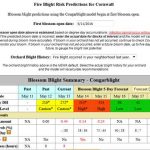A quick note on apple scab: we are likely entering an infection period for the disease starting today through Sunday. If you aren’t covered with a protectant, either get one on between rainshowers or come in with an appropriate kick-back material as soon as possible after the rains stop.
As we enter the bloom period in most Vermont orchards, thoughts naturally turn to potential fire blight infections. This bacterial disease has been on the rise in the state in the past decade or so, and blossom infection is driven by four necessary components: 1) open blooms through which bacteria can enter the plant; 2) wetting events during bloom to move bacteria into susceptible tissues; 3) sufficient heat (daily average over 60°F) during an infection event to permit bacterial reproduction in susceptible tissues; and 4) sufficient levels of bacteria present going into bloom. The first condition is met just by having open blossoms in the orchard, remember that early or late blooming cultivars can extend the window. The second is likely to be met with occasional rains expected today through the weekend. The question remains about whether the other conditions will be met. Forecast temperatures look like sufficient heat will be present today and tomorrow for infection to occur in at least some orchards, particularly in southern Vermont. However, cooler temperatures starting Sunday, May 15 will reduce any risk of infection, at least as far as the near-term forecast is concerned.
The final condition required for infection to occur is a sufficient population of Erwinia amylovera bacteria present in the orchard. Bacteria are present in orchards in differing amounts, and may be present in wild trees surrounding the orchard. The Cougar Blight model used by NEWA to predict infection allows for multiple settings, including “no fire blight occurred in your neighborhood last year”, “fire blight occurred in your neighborhood last year”, and “fire blight is now active in your neighborhood”. Those settings can substantially affect infection predictions, so please adjust the model as appropriate for your orchard. Despite dire warnings of a fire blight apocalypse in 2015 due to the hot weather leading up to and during bloom, dry conditions and growers application of antibiotics prevented much infection at all in the state. Still, if you had fire blight last year or even in recent (2-3) years, consider moving the slider up into the more conservative class if using the NEWA model.
Models require entry of a date for first bloom. This is not your full bloom date, nor is it applicable only to McIntosh. Accumulation of heat units to assess the epiphytic infection potential (a measurement of the potential population level of infective bacteria) is somewhat complicated, but suffice to say that calculations begin within a certain window of bloom and end when all blossoms are gone so earlier bloom date entries may increase EIP substantially. The point of the model is to run given the best conditions and data you have in your orchard and to use that information to make a sound decision. Being too conservative in the model may overestimate potential for infection (and the reverse is true as well).
That said, for most locations in the Champlain and Connecticut Valleys, fire blight infection risk is high for today and tomorrow, and treatment may be appropriate for susceptible cultivars (Cortland, Paulared, Mutsu, Gala, Honeycrisp especially) that are in bloom if you had fire blight anywhere in your orchard last year. Risk drops for all sites to a ‘caution’ level if “no fire blight in your neighborhood last year” is selected. Treatment must be applied within 24 hours of infection (before or after) but only protects blossoms that were open during application. Typically, streptomycin is the best material to use and there is no known resistance to that material in Vermont. Organic growers may no longer use streptomycin and should use a biological like Serenade, possibly coupled with low-rate copper but fruit russeting may occur. Full label rates should be used, and with streptomycin, a wetting agent also included.
Take-home message: At this point I don’t consider fire blight to be a significant risk unless you had the disease in your orchard last year and you have susceptible cultivars in your orchard blooming now. Remember, if you don’t have open blossoms, then you don’t have any risk of the (blossom blight phase of) the disease.


